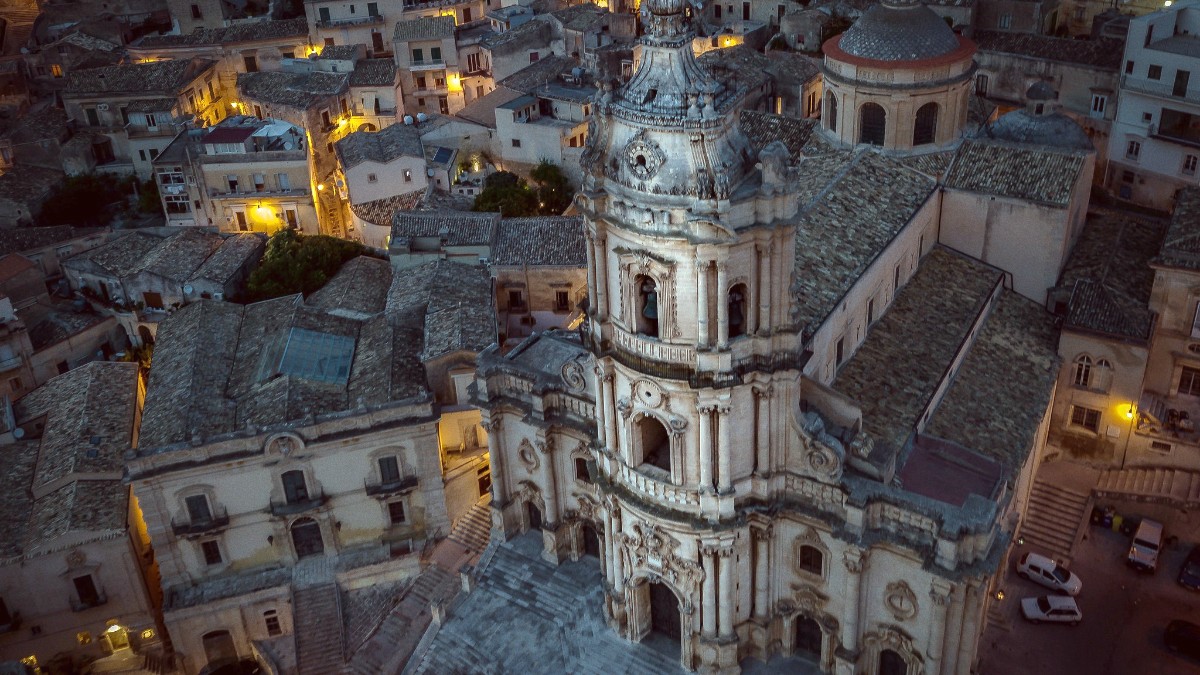
Sicily, Italy
Common ingredients include eggplant (a staple in Sicilian cooking), juicy tomatoes, creamy ricotta cheese (especially from sheep's milk), durum wheat for pasta and bread, and abundant nuts like almonds and pistachios. Local seafood, like swordfish, tuna, anchovies, and various shellfish, appears prominently in coastal-influenced dishes. Citrus fruits, notably oranges and lemons, add freshness and brightness.
Sicilian cuisine, including Modica’s, often balances sweet and sour (agrodolce), a legacy of Arab influence. Herbs like fresh basil, mint, oregano, and parsley are used generously, alongside chili pepper for a subtle kick. Garlic and onions form the aromatic base of many savory preparations. Olive oil is not just an ingredient; it acts as a flavor enhancer and unifier of tastes.
Modica's lunch is typically 1:00 PM-3:00 PM. Dinner begins around 8:00 PM, or later in summer. Many restaurants close between lunch and dinner.
Traditional meals have Antipasto, Primo (pasta/risotto), Secondo (meat/fish), Contorno (side), Dolce, Caffè, Digestivo. Ordering fewer courses is fine.
"Vino della casa" (house wine) is a common, economical choice. Coffee is after the meal. Cappuccino is generally a breakfast drink, not ordered after noon. Espresso is standard.
This unique, grainy, cold-processed chocolate is Modica's most famous culinary export. It is often flavored with chili, vanilla, cinnamon, or citrus.
Find it at numerous chocolate shops (cioccolaterie) throughout the city; Antica Dolceria Bonajuto is the most famous and historic.
These are thin, folded savory pastries, a true local specialty. Fillings vary widely but often include tomato and onion, ricotta and sausage, or various vegetables.
You can find them at local bakeries ("panifici") and some "rosticcerie" (shops selling savory baked goods).
Baked pastries, often filled with flavorful lamb or chicken and potatoes, creating a hearty and satisfying meal wrapped in a golden crust.
Seek these at traditional bakeries.
These iconic fried rice balls are a quintessential Sicilian street food. They typically come filled with ragù (meat sauce), mozzarella, or ham and cheese. Available at rosticcerie, bars, and sometimes even supermarkets.
Crispy fried pastry shells filled with a sweet, creamy ricotta cheese, often adorned with candied fruit or chocolate chips. You can find cannoli throughout Sicily, but Modica's pasticcerie (pastry shops) have excellent versions.
Modica has upscale restaurants with refined Sicilian cuisine, often with modern culinary twists. They emphasize local ingredients. Accursio Restaurant in Modica Bassa is a Michelin-starred establishment giving an elevated dining experience.
These are many in Modica, specifically in Modica Bassa and just outside the main tourist areas. They give traditional Modican and Sicilian dishes in comfortable, often family-run "trattorias" or "osterias." They mean a warm atmosphere and good value.
Numerous pizzerias have delicious and inexpensive pizzas. "Rosticcerie" sell quick savory bites like arancini, scacce, and various fried snacks. Local bars are for an inexpensive breakfast of coffee and a pastry. These are for a quick, authentic, and affordable meal.
Modica has a daily fresh food market (Mercato Ortofrutticolo) where you can buy local produce, cheeses, cured meats, bread, and other provisions. This is excellent for self-catering or preparing picnics.
Discover fresh, seasonal ingredients directly from local vendors.
While traditional Sicilian cuisine dominates Modica, some restaurants may have broader Italian (non-Sicilian) or general Mediterranean fare. Truly international cuisine (e.g., Asian, Mexican) is limited outside of larger cities in Sicily.
Embrace the local flavors for the most authentic experience.
Many Sicilian dishes are naturally vegetarian. Vegan choices require careful ordering, but awareness grows.
Halal and kosher choices are very limited. Consider self-catering or identifiable vegetarian/vegan options.
Awareness grows. Some restaurants have gluten-free pasta/pizza. Inform staff about allergies.
Carry a small card with dietary restrictions in Italian for staff. This lessens misunderstandings.
Check local listings or inquire at the tourist information office for traditional Sicilian folk music or dance performances. These might occur during local festivals or special events.
Religious processions, like the Feast of San Giorgio, give a glimpse into deep-rooted local traditions.
While not a main destination for language schools, learning a few basic Italian phrases before and during your trip significantly improves your interactions with locals.
Small conversation exchanges can happen naturally in local cafes or markets.
Held annually in December, this is a popular festival celebrating Modica chocolate. It features tastings, workshops, masterclasses, and exhibitions, drawing chocolate enthusiasts from around the world.
Look for restaurants carved into ancient cave dwellings, giving an unique ambiance, or those perched with panoramic views of Modica Alta, combining stunning visuals with delicious food.
Many traditional Sicilian dishes are naturally vegetarian, like "pasta alla norma" (pasta with eggplant and ricotta) and "caponata" (sweet and sour eggplant stew).
Vegan options require more careful ordering, but awareness is growing in Italy.
Awareness of gluten-free (senza glutine) diets is increasing. Some restaurants have gluten-free pasta or pizza.
Visit Modica's daily fresh food market to pick local produce and ingredients. A great way to see what is in season.
Ideal for self-catering or picnic preparation.
While international options are few, focus on Modica's rich Sicilian culinary heritage for the most authentic dining experience.
Discover unique regional dishes and flavors.
Experience the unique cold-processed Modica chocolate at various cioccolaterie throughout the town.
Sample excellent local wines from the Val di Noto region, pairing them with traditional Modican dishes.
Indulge in Sicilian pastries like cannoli and cassata from local pasticcerie.
Sicilian cuisine often aligns with religious holidays and festivals. During Easter, you will find specific sweets and savory dishes. During Christmas, various traditional desserts grace the tables.